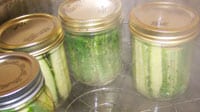Mrs. Wages® makes several packaged mixes to help make home canning easy and quick. All of their mixes for canning use the water bath canning method. But do the mixes have a shelf life?
According to the Mrs. Wages® Frequently Asked Questions website:
“On the side of every Mrs. Wages® pouch is an 8 digit code that you can use to determine when the product was produced, and you will find it stamped into packet, for example B2181A23. The B identifies the facility that produced the mix. The number, which follows, represents the last digit of the year the mix was produced, e.g., a 2 would indicate 2012. The next three numbers indicate which day out of 365 days in the year, the mix was produced. So if the number is 181, it means the product was mixed on June 29th as this is the 181st day of the year. The final 3 digits are used by Kent Precision Foods to indicate the batch code. For optimal performance, we recommend using Mrs. Wages® Pickle, Tomato, Fruit mixes and Fruit Pectins within 24 months of the day and year, it was produced.”

 Packing lunches for school or work can be hectic in the morning, so planning ahead can save time and stress. One way to add convenience is by freezing sandwiches. But keep in mind, some sandwich items freeze better than others.
Packing lunches for school or work can be hectic in the morning, so planning ahead can save time and stress. One way to add convenience is by freezing sandwiches. But keep in mind, some sandwich items freeze better than others.



